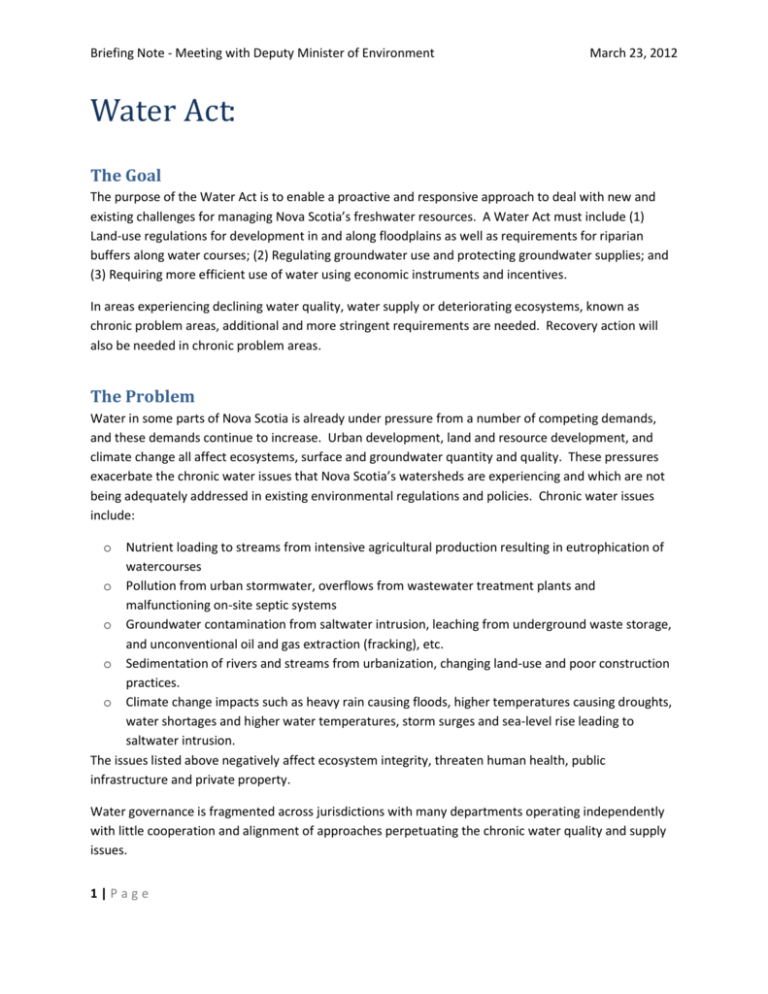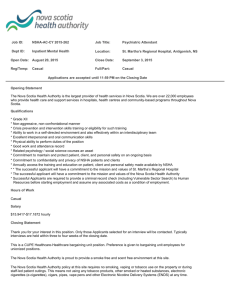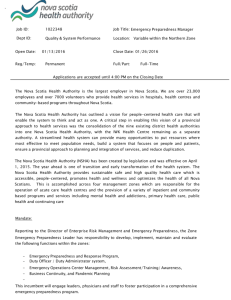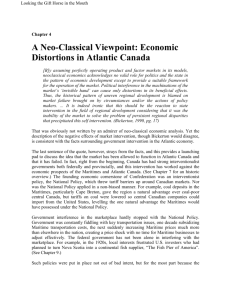Water Act brief - Ecology Action Centre
advertisement

Briefing Note - Meeting with Deputy Minister of Environment March 23, 2012 Water Act: The Goal The purpose of the Water Act is to enable a proactive and responsive approach to deal with new and existing challenges for managing Nova Scotia’s freshwater resources. A Water Act must include (1) Land-use regulations for development in and along floodplains as well as requirements for riparian buffers along water courses; (2) Regulating groundwater use and protecting groundwater supplies; and (3) Requiring more efficient use of water using economic instruments and incentives. In areas experiencing declining water quality, water supply or deteriorating ecosystems, known as chronic problem areas, additional and more stringent requirements are needed. Recovery action will also be needed in chronic problem areas. The Problem Water in some parts of Nova Scotia is already under pressure from a number of competing demands, and these demands continue to increase. Urban development, land and resource development, and climate change all affect ecosystems, surface and groundwater quantity and quality. These pressures exacerbate the chronic water issues that Nova Scotia’s watersheds are experiencing and which are not being adequately addressed in existing environmental regulations and policies. Chronic water issues include: o Nutrient loading to streams from intensive agricultural production resulting in eutrophication of watercourses o Pollution from urban stormwater, overflows from wastewater treatment plants and malfunctioning on-site septic systems o Groundwater contamination from saltwater intrusion, leaching from underground waste storage, and unconventional oil and gas extraction (fracking), etc. o Sedimentation of rivers and streams from urbanization, changing land-use and poor construction practices. o Climate change impacts such as heavy rain causing floods, higher temperatures causing droughts, water shortages and higher water temperatures, storm surges and sea-level rise leading to saltwater intrusion. The issues listed above negatively affect ecosystem integrity, threaten human health, public infrastructure and private property. Water governance is fragmented across jurisdictions with many departments operating independently with little cooperation and alignment of approaches perpetuating the chronic water quality and supply issues. 1|Page Briefing Note - Meeting with Deputy Minister of Environment March 23, 2012 The Need The Province of Nova Scotia needs to take the lead in establishing legislation to protect water resources. A Water Act needs to take a watershed-scale approach and include provisions for protecting stream health and aquatic environments. This can be achieved through land-use regulations for development in and along floodplains as well as requirements for riparian buffers along water courses. A Water Act must also contain regulations for groundwater use and protecting groundwater supplies. Requiring more efficient use of water using economic instruments and incentives is needed as are improved water governance arrangements. Protecting stream health and aquatic environments o Regulating and limiting land-use and development in flood-plains o Requiring riparian buffers along watercourses o Ensure in-stream flows are sufficient to protect aquatic health o Ensure equal standards for all land-uses (forestry, agriculture, natural resource development, and other uses) Water conservation and water use efficiency: large gains can be made to reduce municipal energy consumption from pumping, heating and treating water through residential, commercial and industrial water conservation plans. Regulating groundwater use and protecting groundwater resources Improving water governance arrangements to ensure they are transparent, accountable and inclusive of the public and communities that live within a watershed. Current Approach The focus has been on developing a provincial Water Strategy, as one of the goals under the Environmental Goals and Sustainable Prosperity Act. While this goal was met in 2010 the ability of government staff to accomplish the priorities within the strategy is very limited. The existing Water Strategy has been very slow getting off the mark and with no clear timelines or funding, many are concerned that to a certain extent the Water strategy is creating the illusion that the problems are being addressed. Most importantly the Water Strategy is failing to address the chronic problems that have been affecting Nova Scotia’s watersheds. Le gislation is needed to strengthen existing policies and ensure that the protection of water resources is a priority of all departments, not simply Environment. Opportunities Atlantic Canadians have a high level of concern about quality and quantity of freshwater in Canada. We recognize that water is very important for our prosperity and well being. According to the RBC 2011 Canada Water Attitudes Survey: 2|Page Briefing Note - Meeting with Deputy Minister of Environment March 23, 2012 80% of Canadians polled were very concerned or somewhat concerned with the long term supply/quality of Canada’s freshwater. This number was slightly higher for people from the Atlantic region (81%) and amongst people living in rural areas (82%). 55% of Canadians (54% of Atlantic Canadians) consider freshwater to be Canada’s most important natural resource. Three quarters of Canadians (73%) and 79% of Atlantic Canadians believe that water is very important to Canada’s economy, prosperity and quality of life1. A number of other provinces have passed important water legislation. Ontario passed the Clean Water Act (2006), the Lake Simcoe Protection Act (2008) and the Water Opportunities Act (2010). British Columbia made a commitment to develop a Water Act in their Living Water Smart strategy and they are now moving forward on a Water Modernization Act. Positive Economic Outcome of a Water Act A Water Act will help improve water efficiency which results in significant cost savings for individuals and businesses. For example, a reduction in Ontario’s water demand of 10% in 10 years using only cost-effective measures would save 121 million cubic metres a year and save $500 million dollars in avoided infrastructure costs. Nova Scotia needs to take advantage of the economic opportunity that the water industry provides. The size of the global water industry is estimated at US$360 billion and is forecasted to rise to US$1.6 trillion in 10 years 2. The Water Opportunities Act in Ontario has helped to invigorate the water treatment technologies sector and create jobs in the trades sector (plumbers, pipe fitters, etc). The cost of not protecting our water is high. Water damage now accounts for $1.7 billion in insurance claims per year and has surpassed fire as the largest cost to Canada’s insurance industry. Legislation concerning water conservation can help municipalities around the province that are struggling with ageing infrastructure reduce water usage, reduce energy costs and improve the lifespan of water and wastewater infrastructure. Council of the Federation and Water Charter- July 2012 With the Premiers from all the territories and provinces coming to Nova Scotia in July, this is a great opportunity to show the concrete steps this province is taking to move forward on sustainable water management and legislation. Nova Scotia was one of the first provinces to take a lead on the Water Charter, let us continue to move this important initiative forward both provincially, regionally and nationally. 1 RBC 2011 Canadian Water Attitudes Survey, http://www.cwn-rce.ca/wpcontent/uploads/2011/03/2011_Canadian_Water_Attitudes_Study.pdf 2 Blue Economy Initiative http://www.blue-economy.ca 3|Page







